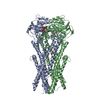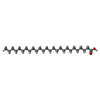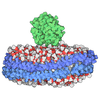+ Open data
Open data
- Basic information
Basic information
| Entry |  | |||||||||
|---|---|---|---|---|---|---|---|---|---|---|
| Title | Cryo-EM structure of human ABCD1 in the presence of C26:0 | |||||||||
 Map data Map data | ||||||||||
 Sample Sample |
| |||||||||
 Keywords Keywords | complex / STRUCTURAL PROTEIN | |||||||||
| Function / homology |  Function and homology information Function and homology informationABC-type fatty-acyl-CoA transporter activity / peroxisomal membrane transport / very long-chain fatty-acyl-CoA catabolic process / very long-chain fatty acyl-CoA hydrolase activity / positive regulation of unsaturated fatty acid biosynthetic process / Linoleic acid (LA) metabolism / Defective ABCD1 causes ALD / alpha-linolenic acid metabolic process / long-chain fatty acid catabolic process / long-chain fatty acid import into peroxisome ...ABC-type fatty-acyl-CoA transporter activity / peroxisomal membrane transport / very long-chain fatty-acyl-CoA catabolic process / very long-chain fatty acyl-CoA hydrolase activity / positive regulation of unsaturated fatty acid biosynthetic process / Linoleic acid (LA) metabolism / Defective ABCD1 causes ALD / alpha-linolenic acid metabolic process / long-chain fatty acid catabolic process / long-chain fatty acid import into peroxisome / very long-chain fatty acid catabolic process / alpha-linolenic acid (ALA) metabolism / regulation of fatty acid beta-oxidation / Beta-oxidation of very long chain fatty acids / sterol homeostasis / Class I peroxisomal membrane protein import / very long-chain fatty acid metabolic process / peroxisome organization / regulation of mitochondrial depolarization / fatty acyl-CoA hydrolase activity / ABC transporters in lipid homeostasis / myelin maintenance / regulation of cellular response to oxidative stress / Hydrolases; Acting on ester bonds; Thioester hydrolases / linoleic acid metabolic process / positive regulation of fatty acid beta-oxidation / regulation of oxidative phosphorylation / fatty acid elongation / Translocases; Catalysing the translocation of other compounds; Linked to the hydrolysis of a nucleoside triphosphate / peroxisomal membrane / long-chain fatty acid transmembrane transporter activity / fatty acid beta-oxidation / ATPase-coupled transmembrane transporter activity / negative regulation of cytokine production involved in inflammatory response / fatty acid homeostasis / negative regulation of reactive oxygen species biosynthetic process / neuron projection maintenance / mitochondrial membrane / ADP binding / peroxisome / protein heterodimerization activity / lysosomal membrane / endoplasmic reticulum membrane / perinuclear region of cytoplasm / enzyme binding / protein homodimerization activity / ATP hydrolysis activity / ATP binding / identical protein binding / membrane / cytosol / cytoplasm Similarity search - Function | |||||||||
| Biological species |  Homo sapiens (human) Homo sapiens (human) | |||||||||
| Method | single particle reconstruction / cryo EM / Resolution: 3.78 Å | |||||||||
 Authors Authors | Chao X / Li-Na J / Lin T | |||||||||
| Funding support |  China, 2 items China, 2 items
| |||||||||
 Citation Citation |  Journal: Signal Transduct Target Ther / Year: 2023 Journal: Signal Transduct Target Ther / Year: 2023Title: Structural insights into substrate recognition and translocation of human peroxisomal ABC transporter ALDP. Authors: Chao Xiong / Li-Na Jia / Wei-Xi Xiong / Xin-Tong Wu / Liu-Lin Xiong / Ting-Hua Wang / Dong Zhou / Zhen Hong / Zheng Liu / Lin Tang /  Abstract: Dysfunctions of ATP-binding cassette, subfamily D, member 1 (ABCD1) cause X-linked adrenoleukodystrophy, a rare neurodegenerative disease that affects all human tissues. Residing in the peroxisome ...Dysfunctions of ATP-binding cassette, subfamily D, member 1 (ABCD1) cause X-linked adrenoleukodystrophy, a rare neurodegenerative disease that affects all human tissues. Residing in the peroxisome membrane, ABCD1 plays a role in the translocation of very long-chain fatty acids for their β-oxidation. Here, the six cryo-electron microscopy structures of ABCD1 in four distinct conformational states were presented. In the transporter dimer, two transmembrane domains form the substrate translocation pathway, and two nucleotide-binding domains form the ATP-binding site that binds and hydrolyzes ATP. The ABCD1 structures provide a starting point for elucidating the substrate recognition and translocation mechanism of ABCD1. Each of the four inward-facing structures of ABCD1 has a vestibule that opens to the cytosol with variable sizes. Hexacosanoic acid (C26:0)-CoA substrate binds to the transmembrane domains (TMDs) and stimulates the ATPase activity of the nucleotide-binding domains (NBDs). W339 from the transmembrane helix 5 (TM5) is essential for binding substrate and stimulating ATP hydrolysis by substrate. ABCD1 has a unique C-terminal coiled-coil domain that negatively modulates the ATPase activity of the NBDs. Furthermore, the structure of ABCD1 in the outward-facing state indicates that ATP molecules pull the two NBDs together and open the TMDs to the peroxisomal lumen for substrate release. The five structures provide a view of the substrate transport cycle and mechanistic implication for disease-causing mutations. | |||||||||
| History |
|
- Structure visualization
Structure visualization
| Supplemental images |
|---|
- Downloads & links
Downloads & links
-EMDB archive
| Map data |  emd_32919.map.gz emd_32919.map.gz | 197.5 MB |  EMDB map data format EMDB map data format | |
|---|---|---|---|---|
| Header (meta data) |  emd-32919-v30.xml emd-32919-v30.xml emd-32919.xml emd-32919.xml | 10.4 KB 10.4 KB | Display Display |  EMDB header EMDB header |
| Images |  emd_32919.png emd_32919.png | 12.1 KB | ||
| Filedesc metadata |  emd-32919.cif.gz emd-32919.cif.gz | 5.6 KB | ||
| Archive directory |  http://ftp.pdbj.org/pub/emdb/structures/EMD-32919 http://ftp.pdbj.org/pub/emdb/structures/EMD-32919 ftp://ftp.pdbj.org/pub/emdb/structures/EMD-32919 ftp://ftp.pdbj.org/pub/emdb/structures/EMD-32919 | HTTPS FTP |
-Validation report
| Summary document |  emd_32919_validation.pdf.gz emd_32919_validation.pdf.gz | 452.8 KB | Display |  EMDB validaton report EMDB validaton report |
|---|---|---|---|---|
| Full document |  emd_32919_full_validation.pdf.gz emd_32919_full_validation.pdf.gz | 452.4 KB | Display | |
| Data in XML |  emd_32919_validation.xml.gz emd_32919_validation.xml.gz | 7 KB | Display | |
| Data in CIF |  emd_32919_validation.cif.gz emd_32919_validation.cif.gz | 8 KB | Display | |
| Arichive directory |  https://ftp.pdbj.org/pub/emdb/validation_reports/EMD-32919 https://ftp.pdbj.org/pub/emdb/validation_reports/EMD-32919 ftp://ftp.pdbj.org/pub/emdb/validation_reports/EMD-32919 ftp://ftp.pdbj.org/pub/emdb/validation_reports/EMD-32919 | HTTPS FTP |
-Related structure data
| Related structure data |  7x07MC  7x0tC  7x0zC  7x1wC  7xecC  7yrqC M: atomic model generated by this map C: citing same article ( |
|---|---|
| Similar structure data | Similarity search - Function & homology  F&H Search F&H Search |
- Links
Links
| EMDB pages |  EMDB (EBI/PDBe) / EMDB (EBI/PDBe) /  EMDataResource EMDataResource |
|---|---|
| Related items in Molecule of the Month |
- Map
Map
| File |  Download / File: emd_32919.map.gz / Format: CCP4 / Size: 209.3 MB / Type: IMAGE STORED AS FLOATING POINT NUMBER (4 BYTES) Download / File: emd_32919.map.gz / Format: CCP4 / Size: 209.3 MB / Type: IMAGE STORED AS FLOATING POINT NUMBER (4 BYTES) | ||||||||||||||||||||||||||||||||||||
|---|---|---|---|---|---|---|---|---|---|---|---|---|---|---|---|---|---|---|---|---|---|---|---|---|---|---|---|---|---|---|---|---|---|---|---|---|---|
| Projections & slices | Image control
Images are generated by Spider. | ||||||||||||||||||||||||||||||||||||
| Voxel size | X=Y=Z: 0.83 Å | ||||||||||||||||||||||||||||||||||||
| Density |
| ||||||||||||||||||||||||||||||||||||
| Symmetry | Space group: 1 | ||||||||||||||||||||||||||||||||||||
| Details | EMDB XML:
|
-Supplemental data
- Sample components
Sample components
-Entire : Cryo-EM structure of human ABCD1 in the presence of C26:0
| Entire | Name: Cryo-EM structure of human ABCD1 in the presence of C26:0 |
|---|---|
| Components |
|
-Supramolecule #1: Cryo-EM structure of human ABCD1 in the presence of C26:0
| Supramolecule | Name: Cryo-EM structure of human ABCD1 in the presence of C26:0 type: complex / ID: 1 / Parent: 0 / Macromolecule list: #1 |
|---|---|
| Source (natural) | Organism:  Homo sapiens (human) Homo sapiens (human) |
| Molecular weight | Theoretical: 170 KDa |
-Macromolecule #1: ATP-binding cassette sub-family D member 1
| Macromolecule | Name: ATP-binding cassette sub-family D member 1 / type: protein_or_peptide / ID: 1 / Number of copies: 2 / Enantiomer: LEVO EC number: Hydrolases; Acting on ester bonds; Thioester hydrolases |
|---|---|
| Source (natural) | Organism:  Homo sapiens (human) Homo sapiens (human) |
| Molecular weight | Theoretical: 85.195117 KDa |
| Recombinant expression | Organism:  Homo sapiens (human) Homo sapiens (human) |
| Sequence | String: MDYKDDDDKG SENLYFQSMP VLSRPRPWRG NTLKRTAVLL ALAAYGAHKV YPLVRQCLAP ARGLQAPAGE PTQEASGVAA AKAGMNRVF LQRLLWLLRL LFPRVLCRET GLLALHSAAL VSRTFLSVYV ARLDGRLARC IVRKDPRAFG WQLLQWLLIA L PATFVNSA ...String: MDYKDDDDKG SENLYFQSMP VLSRPRPWRG NTLKRTAVLL ALAAYGAHKV YPLVRQCLAP ARGLQAPAGE PTQEASGVAA AKAGMNRVF LQRLLWLLRL LFPRVLCRET GLLALHSAAL VSRTFLSVYV ARLDGRLARC IVRKDPRAFG WQLLQWLLIA L PATFVNSA IRYLEGQLAL SFRSRLVAHA YRLYFSQQTY YRVSNMDGRL RNPDQSLTED VVAFAASVAH LYSNLTKPLL DV AVTSYTL LRAARSRGAG TAWPSAIAGL VVFLTANVLR AFSPKFGELV AEEARRKGEL RYMHSRVVAN SEEIAFYGGH EVE LALLQR SYQDLASQIN LILLERLWYV MLEQFLMKYV WSASGLLMVA VPIITATGYS ESDAEAVKKA ALEKKEEELV SERT EAFTI ARNLLTAAAD AIERIMSSYK EVTELAGYTA RVHEMFQVFE DVQRCHFKRP RELEDAQAGS GTIGRSGVRV EGPLK IRGQ VVDVEQGIIC ENIPIVTPSG EVVVASLNIR VEEGMHLLIT GPNGCGKSSL FRILGGLWPT YGGVLYKPPP QRMFYI PQR PYMSVGSLRD QVIYPDSVED MQRKGYSEQD LEAILDVVHL HHILQREGGW EAMCDWKDVL SGGEKQRIGM ARMFYHR PK YALLDECTSA VSIDVEGKIF QAAKDAGIAL LSITHRPSLW KYHTHLLQFD GEGGWKFEKL DSAARLSLTE EKQRLEQQ L AGIPKMQRRL QELCQILGEA VAPAHVPAPS PQGPGGLQGA ST UniProtKB: ATP-binding cassette sub-family D member 1 |
-Macromolecule #2: hexacosanoic acid
| Macromolecule | Name: hexacosanoic acid / type: ligand / ID: 2 / Number of copies: 1 / Formula: 7PO |
|---|---|
| Molecular weight | Theoretical: 396.69 Da |
| Chemical component information |  ChemComp-7PO: |
-Experimental details
-Structure determination
| Method | cryo EM |
|---|---|
 Processing Processing | single particle reconstruction |
| Aggregation state | 3D array |
- Sample preparation
Sample preparation
| Buffer | pH: 7.5 |
|---|---|
| Vitrification | Cryogen name: ETHANE |
- Electron microscopy
Electron microscopy
| Microscope | FEI TITAN KRIOS |
|---|---|
| Image recording | Film or detector model: FEI EAGLE (4k x 4k) / Average electron dose: 66.5 e/Å2 |
| Electron beam | Acceleration voltage: 300 kV / Electron source:  FIELD EMISSION GUN FIELD EMISSION GUN |
| Electron optics | Illumination mode: FLOOD BEAM / Imaging mode: BRIGHT FIELD / Nominal defocus max: 2.5 µm / Nominal defocus min: 1.5 µm |
| Experimental equipment |  Model: Titan Krios / Image courtesy: FEI Company |
- Image processing
Image processing
| Startup model | Type of model: INSILICO MODEL |
|---|---|
| Final reconstruction | Resolution.type: BY AUTHOR / Resolution: 3.78 Å / Resolution method: FSC 0.143 CUT-OFF / Number images used: 731411 |
| Initial angle assignment | Type: ANGULAR RECONSTITUTION |
| Final angle assignment | Type: COMMON LINE |
 Movie
Movie Controller
Controller












 Z (Sec.)
Z (Sec.) Y (Row.)
Y (Row.) X (Col.)
X (Col.)




















